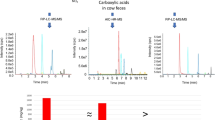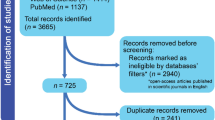Abstract
A newly modified QuEChERS method was developed, validated, and tested in-house for the multiclass, multiresidue determination of organophosphate (OPP) and organochlorine pesticide (OCP) residues in fruits and vegetables. The method incorporated a solvent extraction with acetonitrile followed by partitioning with magnesium sulphate (MgSO4) and sodium chloride (NaCl). The final step involved a dispersive solid phase extraction (d-SPE) clean-up prior to gas chromatography with electron capture detection (GC-ECD) analysis. Apples and lettuce were the selected matrices for fruits and vegetables, respectively in the method development stages. Various combinations of sorbents were tested in the clean-up step. Florisil and MgSO4 (FM) d-SPE proved to be the best combination for the clean-up step for both OCPs and OPPs in both the fruit and vegetable matrices. Recovery values fell within the acceptable range of 70 to 120% (RSD ≤ 20%). The new method is unique as it employs the standard addition calibration technique for the quantification of OCP and OPP residues. Limit of detection, limit of quantification, linearity, recovery analysis, and repeatability were validation parameters used to evaluate the accuracy, precision, and ruggedness of the method. The newly modified QuEChERS method provides a cheaper alternative for the analysis of pesticide residues in fruits and vegetables as samples can be analysed at a fraction of the cost of the original QuEChERS method. The efficacy of the method was tested on several fruits and vegetables from the Central Division of Trinidad and Tobago. OCP and OPP residues were found in 61% of the samples, most of which were above the maximum residue limits.
Similar content being viewed by others
Notes
PM–PSA and MgSO4
FM–Florisil and MgSO4
PMF–PSA, Florisil and MgSO4
PMC–PSA, MgSO4 and Charcoal
FMC–Florisil, MgSO4 and Charcoal
References
Abdoel Wahid, F., Wickliffe, J., Wilson, M., Van Sauers, A., Bond, N., Hawkins, W., Mans, D.; & Lichtveld, M. (2017). Presence of pesicide residues on produce cultivated in Suriname. Environmental Monitoring and Assessment, 189, 1-10.
Ahmad, R., Salem, N. M., Estaitieh, H. (2010). Occurrence of organochlorine pesticide residues in eggs, chicken and meat in Jordan. Chemosphere 78(6), 667-671.
Alawi, M. A., Ammari, N., & Al-Shuraiki, Y. (1992). Organochlorine pesticide contamination in human milk samples from women living in Amman, Jordan. Archives of Environmental Contamination and Toxicology, 23, 235–239.
Anastassiades, M., Scherbaum, E., Tasdelen, B., & štajnbaher, D. (2007). Recent developments in QuEChERS methodology for pesticide multiresidue analysis. In H. Ohkawa, H. Miyagawa, & P. W. Lee (Eds.), Pesticide Chemistry: crop protection, public health, environmental safety (pp. 439–458). Wiley-VCH Verlag GmbH & Co. KGaA.
Anastassiades, M., Lehotay, S. J., štajnbaher, D., & Schenck, F. J. (2003). Fast and easy multiresidue method employing acetonitrile extraction/partitioning and dispersive solid phase extraction for the determination of pesticide residues in produce. Journal of AOAC International, 86(2), 412–431.
Barr, D. B., & Needham, L. L. (2002). Analytical methods for biological monitoring of exposure to pesticides: a review. Journal of Chromatography B, 778, 5–29.
Bempah, C. K., Asomaning, J., Ansong, A. D., Boateng, J., & Asabere, S. B. (2012). Contamination levels of selected organochlorine and organophosphorus pesticides in Ghanian fruits and vegetables. Emirates Journal of Food and Agriculture, 24, 293–301.
Caribbean Agricultural Health and Safety Agency (2014). List of registered pesticides T & T. http://www.cahfsa.org. Accessed 6 November 2019.
Chang Yen, I., Bekele, I., & Kalloo, C. (1999). Use patterns and residual levels of organophosphate pesticides on vegetables in Trinidad, West Indies. Journal of AOAC International, 82(4), 991–995.
Damalas, C. A., & Eleftherohorinos I.G. (2011). Pesticide exposure, safety issues and risk assessment indicators. International Journal of Environmental Research and Public Health, 8(5), 1402–1419.
Dashtbozorgi, Z., Ramezani, M. K., Husain, S. W., Abrumand-Azar, P., & Morowati, M. (2013). Validation of matrix matched calibration for analysis of insecticide and fungicide residues in cucumber and tomato using QuEChERS sample preparation followed by gas chromatography-mass spectrometry. Journal of the Chilean Chemical Society, 58, 1701–1705.
Dasika, R., Tangirala, S., & Naishadham, P. (2012). Pesticide residue analysis of fruits and vegetables. Journal of Environmental Chemistry and Ecotoxicology, 4(2), 19–28.
Ejobi, F., Kanja, L. W., Kyule, M. N., Muller, P., Kruger, J., & Latigo, A. A. R. (1996). Organochlorine pesticide residues in mothers’ milk in Uganda. Bulletin of Environmental, Contamination and Toxicology, 56, 873–880.
Erney, D. R., Gillespie, A. M., Gilvydis, D. M., & Poole, C. F. (1993). Explanation of the matrix-induced chromatographic response enhancement of organophosphorus pesticides during open tubular column gas chromatography with splitless or hot on column injection and flame photometric detection. Journal of Chromatography A, 638(1), 57–63.
Erney, D. R., Pawlowski, T. M., & Poole, C. F. (1997). Matrix-induced peak enhancement of pesticides in gas chromatography: is there any solution. Journal of High Resolution Chromatography, 20(7), 375–378.
European Commission (2016). EU pesticides database. https://ec.europa.eu/food/plant/pesticides/eu-pesticides-database/public/?event=pesticide.residue.selection&language=EN. Accessed 10 October 2019.
European Commission (2017). SANTE/11813/2017. Guidance document on analytical quality control and method validation procedures for pesticide residues and analysis in food and feed. https://ec.europa.eu/food/sites/food/files/plant/docs/pesticides_mrl_guidelines_wrkdoc_2017-11813.pdf. Accessed 6 March 2019.
Farre, M., Pico, Y., & Barcelo, D. (2014). Application of ultra-high pressure liquid chromatography linear ion-trap orbitrap to qualitative and quantitative assessment of pesticide residues. Journal of Chromatography A, 1328, 66–79.
Food and Agricultural Organization of the United Nations and World Health Organization (2019). Codex Alimenatarius international food standards. Pesticide index. http://www.fao.org/fao-who-codexalimentarius/codex-texts/dbs/pestres/pesticides/en/. Accessed 10 August 2019.
Gillespie, A. M., Daly, S. L., Gilvydis, D. M., Schneider, F., & Walters, S. M. (1995). Multicolumn solid-phase extraction clean-up of organophosphorus and organochlorine pesticide residues in vegetable oils and butterfat. Journal of AOAC International, 78(2), 431–437.
Hajou, R. M. K., Afifi, F. U., & Battah, A. H. (2004). Comparative determination of multi-pesticide residues in Pimpinella anisum using two different AOAC methods. Food Chemistry, 88, 469–478.
Hajslova, J., Holadova, K., Kocourek, V., Poustka, J., Godula, M., Cuhra, P. & Kempny, M. (1998). Matrix-induced effects: a critical point in the gas chromatographic analysis of pesticide residues. Journal of Chromatography A, 800, 283–295.
Health and Safety Executive (2019). The applicant guide: maximum residue levels and import tolerances. https://www.hse.gov.uk/pesticides/pesticides-registration/applicant-guide/maximum-residue-levels.htm. Accessed 30 November 2019.
Ho, Y. M., Tsoi, Y.-K., & Leung, K. S.-Y. (2013). Highly sensitive and selective organophosphate screening in twelve commodities of fruits, vegetables and herbal medicines by dispersive liquid-liquid microextraction. Analytica Chimica Acta, 775, 58–66.
Jallow, M. F. A., Awadh, D.G., Albaho, M. S., Devi, V. Y., & Ahmah, N. (2017). Monitoring of pesticide residues in commonly used fruits and vegetables in Kuwait. International Journal of Environmental Research and Public Health, 14(8), 1–12.
Kwon, H., Lehotay, S., & Geis-Asteggiante, L. (2012). Variability of matrix effects in liquid and gas chromatography-mass spectrometry analysis of pesticide residues after QuEChERS sample preparation of different food crops. Journal of Chromatography A, 1270, 235–245.
Lagunas-Allué, L., Sanz-Asensio, J., & Martinez-Soria, M. T. (2012). Comparison of four extraction methods for the determination of fungicide residues in grapes through gas chromatography-mass spectrometry. Journal of Chromatography A, 1270, 62–71.
Lehotay, S. J., Son, K., Kwon, H., Koesukwiwat, U., Fu, W., Mastovska, K., Hoh, E., & Leepipatpiboon, N. (2010). Comparison of QuEChERS sample preparation methods for analysis of pesticide residues in fruits and vegetables. Journal of Chromatography A, 1217, 2548–2560.
Li, L., Li, W., Qin, D., Jiang, S., & Liu, F. (2009). Application of graphitized carbon black to the QuEChERS method for pesticide multiresidue analysis in spinach. Journal of AOAC International, 92, 538–547.
Li Q., Nagahara, N., Takahashi, H., Takeda, K., Okumura, K., Minami, M. (2002). Organophosphate pesticides markedly inhibit the activities of natural killer, cytotoxic T lymphocyte and lymphokine-activiated killer: a proposed inhibiting mechanism via granzyme inhibition. Toxicology, 172, 181–190.
Masia, A., Suarez-Varela, M. M., Llopis-Gonzales, A., & Pico, Y. (2016). Determination of pesticides and veterinary drug residues in food by liquid chromatography-mass spectrometry: a review. Analytica Chimica Acta, 936, 40–61.
Nasir, K., Bilto, Y. Y., & Al-Shuraiki, Y. (1998). Residues of chlorinated hydrocarbon insecticides in human milk of Jordanian women. Environmental Pollution, 99, 141–148.
Salem, N. M., Ahmad, R., & Estaitieh, H. (2009). Organochlorine pesticides in dairy products in Jordan. Chemosphere, 77(5), 673–678.
Shrivastava, A., & Gupta, V. B. (2011). Methods for the determination of limit of detection and limit of quantification of the analytical methods. Chronicles of Young Scientists, 2, 21–25.
Walorczyk, S., Drozdzynski, D., Kowalska, J., Remlein-Starosta, D., Ziolkowski, A., Przewozniak, M., & Gnusowski, B. (2013). Pesticide residues determination in polish organic crops in 2007-2010 applying gas chromatography-tandem quadrupole mass spectrometry. Food Chemistry, 139, 482–487.
Funding
This work was supported and funded by the Office of Graduate Studies and Research, and the Department of Chemistry, The University of the West Indies, St Augustine Campus, St. Augustine, Trinidad and Tobago.
Author information
Authors and Affiliations
Corresponding author
Ethics declarations
Conflict of interest
The authors declare that they have no conflict of interest.
Ethical issues
There are no ethical issues to declare.
Additional information
Publisher’s note
Springer Nature remains neutral with regard to jurisdictional claims in published maps and institutional affiliations.
Rights and permissions
About this article
Cite this article
Collimore, W.A., Bent, GA. A newly modified QuEChERS method for the analysis of organochlorine and organophosphate pesticide residues in fruits and vegetables. Environ Monit Assess 192, 128 (2020). https://doi.org/10.1007/s10661-020-8072-1
Received:
Accepted:
Published:
DOI: https://doi.org/10.1007/s10661-020-8072-1




